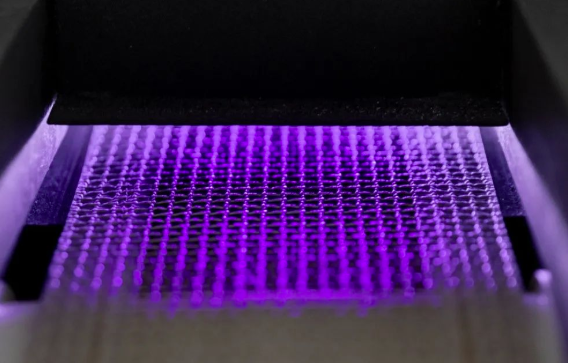
The first generation of light-curing waterborne coatings – external emulsification type.
Through the addition of surfactants (emulsifiers), and supplemented by high shear force, it is possible to emulsify the traditional light-curing resin into a water-dispersible system. This emulsion has a high solid content and can be used directly with readily available coating materials, making the production process relatively simple.
The emulsifier is composed of hydrophilic and lipophilic groups, the latter is generally a long alkane chain, and the resin droplets are miscible, the remaining hydrophilic groups are exposed outside the droplets, forming a hydrophilic layer. The remaining hydrophilic groups are exposed outside the droplets, forming a hydrophilic layer.
The acidity and alkalinity in the system will change the state of the particle groups and thus affect the stability of the emulsion droplets, so this kind of external emulsion coating is very sensitive to the change of PH value, at the same time, excessive shear stress may also lead to the destruction of the double electric layer of the emulsion droplets and lead to emulsion breakage, which brings inconvenience to the production and application.
Another shortcoming is that the applied emulsifier is still present in the coating film after curing, which makes its moisture resistance degraded and affects the quality of the dry film.
The second generation of light-curing water-based coatings – non-ionic-based self-emulsifying type.
In order to avoid additional emulsifier, non-ionic hydrophilic chain segments are introduced into the resin, such as polyethylene glycol chain segments, so that the resin can be stably dispersed in water by itself.
Since the resin itself is hydrophilic, it can be stably dispersed without the need for an additional emulsifier, and it is not as sensitive to the system ph value as external emulsification type coatings. This system, if subdivided, can also be divided into water-soluble and water-dispersible systems.
In the former case, the components are completely dissolved in water in the molecular state; in the latter case, they form larger micelles and are dispersed in water like emulsions, i.e. self-emulsification. Obviously, when the molecules are highly hydrophilic, they tend to form aqueous solutions, while lower hydrophilicity tends to form self-emulsifying dispersions.
In practice it is sometimes difficult to define the two, because for hydrophilic resins with long molecular chains, the particle size reaches the size of an emulsion bundle even when dissolved in water.
As the molecular chain with hydrophilic groups, it will not be eliminated even after light curing, so the water and chemical resistance of the cured film of this type of coating is poor compared with the traditional light-curing coating.
The third generation of light-curing water-based coatings – mixed with water-dispersible resin solution.
Composed of a light-curable hydrophilic polymer mixed with a physically dry water-dispersible resin (usually an acrylic resin), the light-curable polymer component is dispersed in the aqueous phase by a non-light-curable water-dispersible acrylic resin.
Compared to the first generation of light-curable waterborne coatings, this is equivalent to replacing the emulsifier with a large molecule emulsifier. Because of the low content of the light-curable component in the whole system, the resulting cured film has a low cross-link density and thus has a lower chemical resistance compared to conventional light-curable systems.
The fourth generation of light-curing water-based coatings – ion-based self-emulsifying type.
The ionic group is introduced into the resin skeleton, and then the ions on the molecular chain are neutralized with counter ions, so that the resin obtained has good self-emulsifying properties.
Due to excellent wettability, very small particles can be formed in water, and thus the shelf life can be very long, while having very good shear stability.
The application areas of light-cured waterborne coatings are not yet fully known, and its development and application is still in its infancy. What is known is that it can be used as plastic varnish, overprint varnish, photopolymer printing plate, screen printing ink, gravure and lithographic printing ink, metal coating, etc.
Light-curing wash coatings are more suitable for use as screen printing inks and coloring coatings. Many high quality printing use multi-color overprinting process, the low dry film weight index of the coating is very important to get good surface roughness of the cured film, low solid content of light-curing water-based coatings can meet this requirement.
From the aesthetic point of view, more low solid content varnish formulations are used to strengthen the pore structure of the wood surface and increase the wood aesthetics, making it free from looking like a plastic film.
Many of the current wood finishes are non-glossy, so if you want to obtain a low gloss cured film from a light-cured water-based coating, you can use a low solids system to make the film shrink moderately when drying and curing, exposing the silica or other organic matting agents in it partially to the film surface.
In fact, it is also difficult to obtain high gloss cured films from light-cured waterborne coatings. For some wood substrates, the use of light-cured waterborne coatings may induce burrs on the wood surface, the extent of which depends on the nature of the base resin and the surface wood structure of the substrate itself.
As the domestic environmental regulations are becoming more and more perfect and strict, light-curing coatings / ink technology in recent years in the domestic development of faster, but light-curing water-based coatings / ink technology in the country is still a blank.
In recent years, domestic publications have published reviews and research reports on light-curing water-based coating technology, which shows that domestic attention to this technology has begun.
